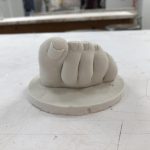
I have previously worked with alginate before in Plaster Workshop, as well as throughout the plaster project. Because I previously completed a design of my hands, I wanted to adventure into a cast of my foot, or toes. The containers that we had use of only fit my toes, but I felt that this was sufficient for the cast that I wanted to get out of it. The alginate is a one time mould.
- Get items ready for casting – tubs, water, item for casting
- Add water to alginate. Different consistencies have different purposes;
- THICK ALGINATE: this can be used on areas such as the face, ears, and vertical surfaces. Apply to the area with a paintbrush, getting into all the nooks and crannies for detail. Keep still, and once dry take off the cast. Make a mother mould using plaster bandages dipped in water. This keeps the alginate in shape.
- THIN ALGINATE: place the object in the desired position in the tub and pour the alginate around the item. Tap the container to get rid of air bubbles in the alginate and allowing it to settle around the object. Keep still, and once dry take the item out of the cast.
- Mix up plaster – pour a thinner mixture first to capture details. Keep adding until the mould is full, tapping the mould to get rid of air bubbles.
- Once the plaster is dry, take off the alginate to reveal the plaster cast.
I was very pleased and surprised with the level of detail that the alginate and plaster were able to capture, as it even grabbed the dirt that was sat on the bottom of my foot. There is a certain delicacy with only doing the toes, and showing the sole of the foot which is often covered and protected. The added base keeps it routed the wrong way up.











Leave a Reply